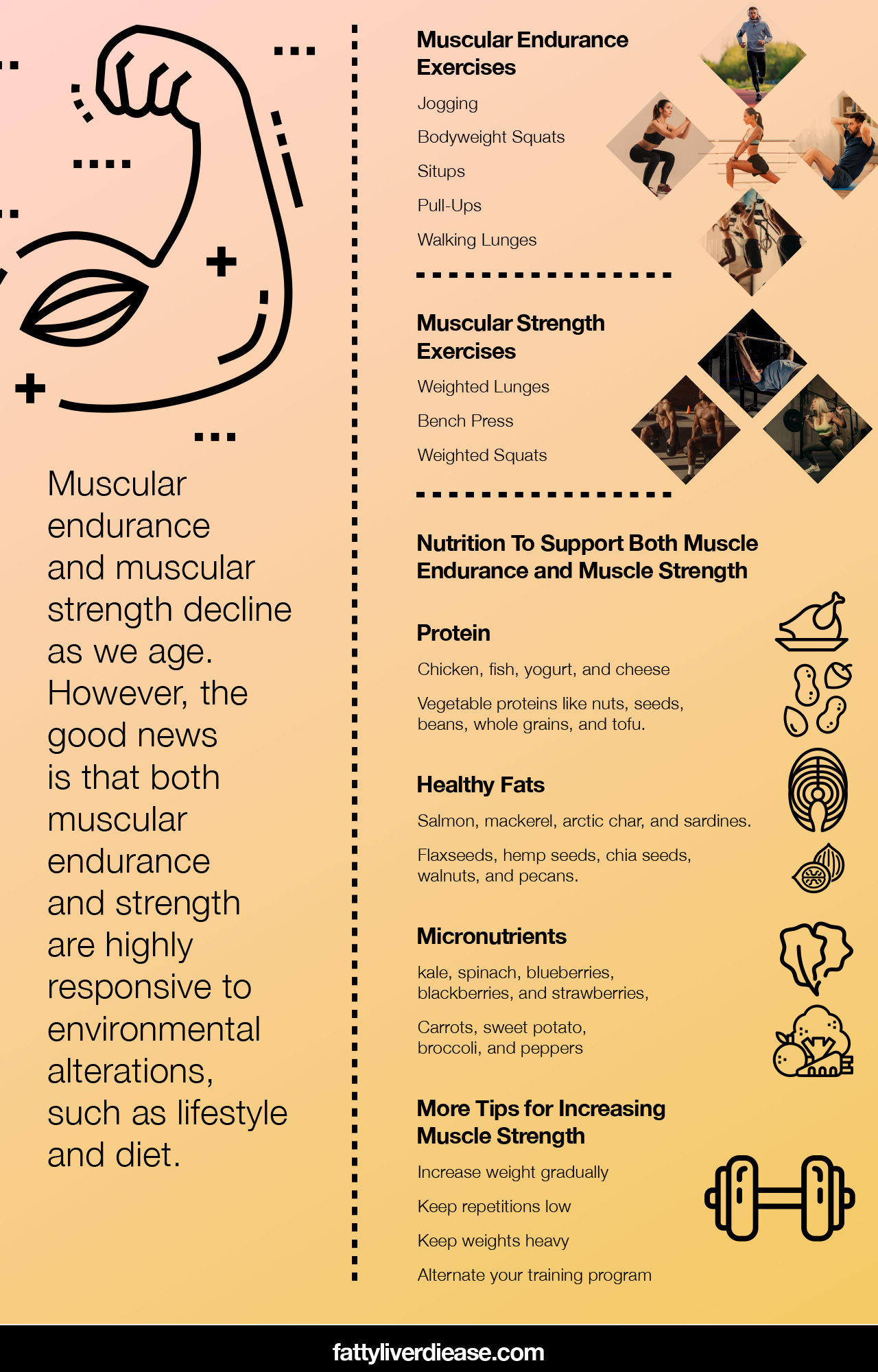In the health and fitness world, we hear a lot about how important it is to increase our muscular strength. But what about muscular endurance? The truth is, muscular endurance is just as crucial to our wellbeing as muscular strength. Both aspects of muscle health contribute to our overall quality of life and longevity.
Keep reading to find out everything you need to know about improving muscle health, including muscular endurance exercises, muscular strength exercises, and proper nutrition for supporting muscle growth and maintenance.
Muscular Endurance vs Muscular Strength: What Is the Difference?
Before we dive into ways to improve muscle health, let’s first look at the difference between muscle endurance and muscle strength.
What is muscular endurance? Muscular endurance describes the ability of your muscles to continue a certain activity without getting fatigued. Having good muscular endurance is what’s important for sustaining everyday activities. Walking, sitting upright at your desk, and standing for extended periods of time are muscular endurance examples.
Muscular strength, on the other hand, refers to how much weight you can lift or push. Tests of muscular strength are short-lived and require a burst of energy. Examples of muscular strength include pushing a car with a dead battery or carrying luggage up a flight of stairs.
If you have both excellent muscular strength AND endurance, you can sustain a more difficult activity for a longer period of time. For example, you can carry a heavy piece of luggage up several flights of stairs, instead of getting fatigued after carrying a light piece of luggage up one flight of stairs. In sports medicine, having a high level of fitness in muscle endurance and muscle strength helps prevent injury.
A Closer Look at Muscle Fibers
The difference between muscular endurance and muscular strength can be determined on a molecular level. If we were to zoom in on muscle fibers, we would see that they can be split into two categories: fast switch and slow twitch.
Slow-twitch muscle fibers – also known as type 1 muscle fibers – are helpful for supporting physical activities that rely on endurance. These muscle fibers depend on aerobic metabolism to survive, which means they convert oxygen and glucose into adenosine triphosphate (ATP) to power movements. Slow-twitch fibers essentially conserve their energy, releasing it at a slower rate so that you can perform a physical task over a prolonged period of time.
On the other hand, fast-twitch muscle fibers operate by generating energy quickly. For example, you are utilizing fast-twitch muscle fibers when you sprint or engage in heavy weightlifting. Working your fast-twitch muscle fibers is what builds muscle mass. Fast-twitch muscle fibers do not depend on oxygen for energy, and instead, rely on anaerobic processes to power cellular processes. As a result, lactic acid builds up, leading to the burn that you feel in your muscles after a short-lived but powerful exertion. Fast-twitch muscle fibers are also referred to as type 2 muscle fibers.
Muscular Endurance and Muscular Strength Decline with Age
Both muscular endurance and muscular strength decline as we age. However, the good news is that both muscular endurance and strength are highly responsive to environmental alterations, such as lifestyle and diet.
Muscular Endurance Exercises
Even though muscular endurance naturally declines as we get older, regularly engaging in certain exercises can help reverse that process. Here are examples of exercises that you can use to improve your muscular endurance. We’ve included exercises that you can do either at the gym or at home, depending on what you have access to.
1. Jogging
Think jogging is just an aerobic exercise? Think again! Many aerobic exercises are also tests of muscular endurance. For example, when you first start jogging, your cardiovascular system and leg muscles are not yet conditioned to run long distances. You will likely feel fatigued after just 1 mile, or even half a mile. As you run more consistently, your cardiovascular system and leg muscles will become conditioned, so that they don’t get fatigued until you’ve run several miles. Jogging increases cardiovascular endurance as well as the muscular endurance of the lower body.
2. Bodyweight Squats
Unweighted squats are a great way to build up your endurance in the glutes and leg muscles. Simply stand with your feet shoulder-width apart, clasp your hands in front of your chest, and keep your back straight. Lower yourself like you’re going to sit in a chair before then standing up again. Repeat times as you can, until your muscles are fatigued.
3. Situps
Situps are another bodyweight exercise that you can be used to increase muscle endurance. To perform a situp, lie on a yoga mat or gym mat. Bend your knees and keep your feet on the ground. Cross your arms over your chest and sit all the way up, so that your arms touch your knees. Then return to the lying position. A good variation of situps is crunches, which can be performed by sitting only halfway up before returning to lying position.
4. Pull-Ups
Pull-ups are excellent bodyweight exercises that challenge the upper body, including the triceps and lats. Complete as many pull-ups as possible until your upper body feels fatigued. You can find pull-up bars at the gym or an outdoor playground.
5. Walking Lunges
To complete walking lunges, take a large step by placing one foot far in front of the other. When you lower yourself towards the ground, your front knee should form a right angle. Then stand up straight again, and take a step with your other foot. Walk across the room as many times as you can, until your lower body muscles become exhausted.
More Tips for Increasing Muscle Endurance
- Stay consistent: The more consistent you are with your endurance workouts, the more your slow-twitch muscle fibers will “learn” how to exert energy over prolonged periods of time.
- Push yourself to fatigue. It’s important to establish where your current limits are so that you can learn to surpass them. To identify your limits, complete repetitions until your muscles cannot complete repetitions anymore. Counting your repetitions helps you maintain a benchmark. You will likely start with a low number of repetitions, and as your muscle endurance increases, you will eventually be able to complete a high number of repetitions over long periods of time.
- Bodyweight exercises are key. Intense weight training is not helpful for targeting your muscle endurance, simply because it’s nearly impossible to complete high repetitions when you are lifting heavyweights.
- Engage in circuit training. Circuit training refers to rotating between different exercises and completing a high number of repetitions for each exercise. For example, perhaps your first station is 25 situps. Then you progress through 20 pushups, 25 squats, etc. The time for rest in between exercises is minimal, and your muscles are pushed to fatigue. You may complete this circuit several times, which is called a superset.
- If you use weights, make sure they are light. To zero in on your muscle endurance, using lighter weights is important to ensure you can reach a high number of repetitions and continue the exercise for long periods of time.
Muscular Strength Exercises
Exercises that test muscular strength are described as resistance training. You can transform many muscular endurance exercises into muscular strength exercises, simply by adding weights. The weights should be heavy enough so that you can only perform 10 repetitions or fewer, but not so heavy that you are unable to maintain good form.
1. Weighted Lunges
Weight lunges are an excellent way to increase the muscular strength in your lower body. As you perform walking lunges, simply carry dumbbells in each hand. You can choose whichever weight you desire, depending on your fitness level. Carry the dumbbells by your side as you complete lunges.
2. Bench Press
Bench pressing isn’t just for bodybuilders! Bench pressing is a great weight training activity to help anyone build up their physical strength in the upper body. To challenge your muscles, make sure you choose barbells that are at your limit. Always make sure you have a spotter.
3. Weighted Squats
Weighted squats are a great way to challenge your lower body muscles. Simply hold dumbbells in each hand, propped up by your shoulders. You can turn weighted squats into a full-body workout by performing a shoulder press with the dumbbells, and as you return to a standing position, use full-body power to lift the weights over your head.
More Tips for Increasing Muscle Strength
- Gradually increase weight. When you first begin strength training, you won’t be able to lift very heavy weights, and that’s ok! Start with weights that are challenging and match your fitness level, but are not too heavy. Gradually increase the weight as you get stronger.
- Keep repetitions low. When you are completing a workout routine that is focused on heavy lifting, you will need to keep repetitions between 5 and 10. This is because the weight should simply be too heavy for more repetitions.
- Keep weights heavy. Keeping weights heavy is crucial for increasing muscle strength. Heavier weights are responsible for helping you build muscle mass.
- Recovery is crucial. When you lift heavy weights, microtears occur in your muscle tissues. Your muscles then require time to heal these tears, in the process bulking up your muscle mass. Avoid working out the same muscle groups two days in a row. Instead, alternate your training program to hit different muscle groups on different days.
Proper Nutrition Supports Both Muscle Endurance and Muscle Strength
Eating nutritious food is vital to supporting better muscle endurance and strength. Here are a few tips for ways to support your muscle endurance and muscle strength with the foods you eat.
1. Protein
Eating plenty of high-quality protein is probably the single most important component of your diet when it comes to building muscle endurance and muscle strength. Why is protein so vital to muscle health? Protein offers amino acids, which are crucial for producing neurotransmitters, enzymes, and hormones, as well as building and maintaining muscle tissue. Without amino acids, none of our cells could function normally! The human body is able to synthesize some amino acids on its own, but the essential amino acids must be obtained from dietary sources. Especially when you are engaging in a rigorous workout plan to maintain and build muscle strength and endurance, you must make sure to get balanced ratios of essential amino acids each day. Getting essential amino acids is also particularly important if you are an older adult since the body naturally loses muscle during the aging process.
What can you do to get more protein? Eat the right foods. You can get balanced ratios of essential amino acids from animal products like chicken, fish, yogurt, and cheese. If you follow a plant-based diet, you can ensure that you get optimal ratios of essential amino acids by eating a variety of vegetable proteins like nuts, seeds, beans, whole grains, and tofu.
2. Healthy Fats
Healthy fats like omega-3 fatty acids help reduce systemic inflammation and help the body heal and build new muscle tissue. Omega-3 fatty acids can be found in fish as well as nuts and seeds. The types of omega-3 fatty acids found in fish are called eicosapentaenoic acid (EPA) and docosahexaenoic acid (DHA). You can get these forms of omega-3 fatty acids in fish like salmon, mackerel, arctic char, and sardines.
Omega-3 fatty acids can also be found in vegetable proteins in the form of alpha-linolenic acid (ALA). You can get ALA from foods like flaxseeds, hemp seeds, chia seeds, walnuts, and pecans.
3. Micronutrients
Micronutrients include tiny compounds found in plant foods, like vitamins, minerals, and antioxidants. All of these compounds are crucial for facilitating cellular processes, lowering inflammation, and reducing oxidative stress in the body. Antioxidants even help the immune system work more efficiently to rebuild muscle tissue more effectively.
To boost your body’s repair mechanisms and reduce inflammation, eat plenty of fruits and veggies like kale, spinach, blueberries, blackberries, strawberries, carrots, sweet potato, broccoli, and peppers.
Improving Muscular Endurance and Strength: Conclusion
Muscular endurance and muscular strength are different aspects of muscle health. Muscular endurance describes how the body can sustain certain activities over an extended period of time, while muscular strength refers to how powerful muscles can perform in a short period of time. Maintaining both muscle endurance and strength is important for overall health, helping you carry out daily activities with ease while also maintaining a high metabolism. Engaging in specialized activities and eating the right foods can help you improve both muscle endurance and strength.
























